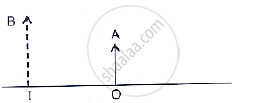Advertisements
Advertisements
Question
An object is placed 20 cm from (a) a converging lens, and (b) a diverging lens, of focal length 15 cm. Calculate the image position and magnification in each case.
Solution
) Focal length of the converging lens, i.e., convex lens f = + 15 cm
Object distance u = - 20 cm
Using the lens formula:
`1/f=1/v-1/u`
⇒`1/15=1/v-1/-20`
⇒`1/15=1/v+1/20`
⇒`1/v=1/15-1/20`
⇒`1/v=(4-3)/60=1/60`
∴ v = +60 cm.
Therefore, the image formed is real. It is at a distance of 60 cm from the lens and to its right.
`"Magnification" ="image distance"/ "object distance"`
∴ `m=v/u=60/-20=-3`
The magnification is greater than 1. Therefore, the image is magnified.
The negative sign shows that the image is inverted.
(b) Focal length of the diverging lens, i.e., concave lens f = - 15 cm
Object distance u = - 20 cm
Using the lens formula:
`1/f=1/v-1/u`
⇒`1/-15=1/v-1/-20`
⇒`1/v=1/-15-1/20`
⇒`1/v=(-4-3)/60=-7/60`
∴ v = - 8.57 cm.
Therefore, the image formed is virtual. It is at a distance of 8.57 cm from the lens and to its left.
`"Magnification"="image distance"/"object distance"`
∴ `m=v/u=(-8.57)/-20=+0.42`
The magnification is less than 1. Therefore, the image is diminished. The positive sign indicates that the image is erect.
APPEARS IN
RELATED QUESTIONS
A student focuses the image of a well-illuminated distant object on a screen using a convex lens. After that, he gradually moves the object towards the lens and each time focuses its image on the screen by adjusting the lens.
(i) In which direction, towards the screen or away from the screen, does he move the lens?
(ii) What happens to the size of the image? Does it decrease or increase?
(iii) What happens to the image on the screen when he moves the object very close to the lens?
Fill in the following blank with suitable word:
Parallel rays of light are refracted by a convex lens to a point called the ........
Find the nature, position and magnification of the images formed by a convex lens of focal length 0.20 m if the object is placed at a distance of:
0.50 m
The given below figure shows an object OA and its image IB formed by a lens. State three characteristics of the image.

In the following cases, where must an object be placed in front of a convex lens so that the image formed is inverted and enlarged?
A lens always forms an image between the object and the lens.
A lens always forms an image between the object and the lens.
Answer the following question.
List four precautions which a student should observe while determining the focal length of a given convex lens by obtaining an image of a distant object on a screen.
State the nature and position of the object on the principal axis to obtain a real image of the same size
_______ is a combination of two convex lenses with small focal length.
Distinguish between:
Concave lens and Convex Lens
